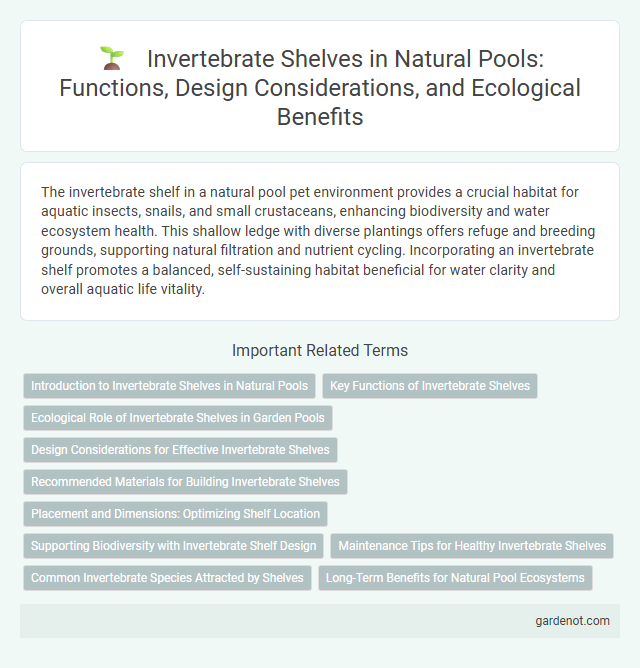The invertebrate shelf in a natural pool pet environment provides a crucial habitat for aquatic insects, snails, and small crustaceans, enhancing biodiversity and water ecosystem health. This shallow ledge with diverse plantings offers refuge and breeding grounds, supporting natural filtration and nutrient cycling. Incorporating an invertebrate shelf promotes a balanced, self-sustaining habitat beneficial for water clarity and overall aquatic life vitality.
Introduction to Invertebrate Shelves in Natural Pools
Invertebrate shelves in natural pools create essential habitats that support biodiversity by providing sheltered zones for aquatic insects, crustaceans, and mollusks. These shallow, gently sloping areas are designed to mimic natural environments, enhancing water filtration and nutrient cycling while promoting a balanced ecosystem. Incorporating invertebrate shelves into natural pool design ensures stable populations of beneficial organisms that contribute to water clarity and ecological health.
Key Functions of Invertebrate Shelves
Invertebrate shelves serve as crucial biofilters in natural pools by supporting diverse microorganisms that break down organic matter and improve water quality. These structures provide habitat for beneficial invertebrates, which contribute to nutrient cycling and help control algae growth. Their filtration capacity enhances water clarity and promotes a balanced aquatic ecosystem essential for maintaining natural pool health.
Ecological Role of Invertebrate Shelves in Garden Pools
Invertebrate shelves in natural garden pools serve as critical habitats supporting biodiversity by providing refuge and breeding grounds for aquatic insects and microfauna, which contribute to the biological filtration process. These structures enhance nutrient cycling by facilitating the breakdown of organic matter, thereby maintaining water quality and ecosystem balance. Integrating invertebrate shelves promotes a self-sustaining environment that reduces reliance on chemical treatments and mechanical filtration systems.
Design Considerations for Effective Invertebrate Shelves
Effective invertebrate shelves in natural pools require carefully selected materials such as porous stones and native aquatic plants to provide optimal habitat complexity and surface area for invertebrate colonization. The shelf design should ensure proper water flow and oxygenation to support diverse invertebrate communities, enhancing the biological filtration and ecosystem balance. Shelf placement at varying depths maximizes species diversity and offers refuge from predators, contributing to the overall health and stability of the natural pool environment.
Recommended Materials for Building Invertebrate Shelves
Recommended materials for building invertebrate shelves in natural pools include untreated hardwood, PVC, and natural stone, all offering durability and resistance to water degradation. Untreated hardwood provides a natural habitat texture beneficial for aquatic invertebrates, while PVC ensures long-lasting structural integrity without leaching harmful chemicals. Natural stone mimics the natural environment, supporting diverse invertebrate communities by offering varied surfaces for attachment and shelter.
Placement and Dimensions: Optimizing Shelf Location
The invertebrate shelf in a natural pool should be positioned within the shallow zone, ideally at a depth of 15 to 30 centimeters, to maximize sunlight exposure and oxygen levels essential for invertebrate habitats. Dimensions typically range from 1 to 2 meters in length and 0.3 to 0.5 meters in width, providing sufficient surface area for colonization by aquatic plants and microorganisms. Proper placement near inflow areas enhances nutrient availability, promoting biodiversity and ecological balance within the pool ecosystem.
Supporting Biodiversity with Invertebrate Shelf Design
The invertebrate shelf in a natural pool provides essential habitats for various aquatic insects, mollusks, and crustaceans, fostering a rich and balanced ecosystem. Designed with diverse plant species and varied substrate materials, it encourages the proliferation of bioindicators that maintain water quality and support fish and amphibian populations. This biodiversity boost enhances natural filtration processes and stabilizes the pool's ecological health over time.
Maintenance Tips for Healthy Invertebrate Shelves
Regularly inspect the invertebrate shelf for debris and algae buildup to ensure optimal water quality and prevent habitat disruption. Implement gentle water circulation techniques to maintain oxygen levels without disturbing delicate invertebrate species. Schedule periodic removal of excess organic matter and monitor water parameters such as pH, temperature, and nutrient concentrations to promote a balanced ecosystem on the invertebrate shelf.
Common Invertebrate Species Attracted by Shelves
In natural pools, invertebrate shelves create essential habitats that attract diverse species such as freshwater snails, dragonfly larvae, and water beetles. These shelves provide shelter, breeding grounds, and feeding opportunities, promoting biodiversity and ecological balance. Effective design enhances colonization by detritivores and filter feeders, improving water quality and ecosystem health.
Long-Term Benefits for Natural Pool Ecosystems
The invertebrate shelf in natural pools provides essential habitat complexity that supports diverse aquatic invertebrate populations, enhancing ecosystem resilience. This biodiversity contributes to improved water quality through natural filtration and nutrient cycling, reducing the need for mechanical intervention. Over time, the shelf promotes stable ecological balance, fostering healthier aquatic environments and supporting sustainable biodiversity conservation.
Invertebrate shelf Infographic

 gardenot.com
gardenot.com